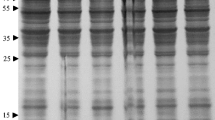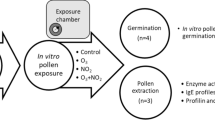Abstract
Airborne pollen is an important and potent source of allergens. Allergenic protein components located in the cytoplasm of pollen, so-called pollen cytoplasmic granules, are released upon contact with moisture, thereby inducing allergic symptoms. However, few studies have compared factors affecting pollen rupture and protein release from allergenic pollen. This study investigated the dynamics of pollen rupture and protein release upon hydration using common allergenic grass and weed species in subtropical regions. The three factors examined were incubation time, incubating solution, and pollen age after shedding. We found that pollen rupture and protein release occurred rapidly upon contact with solutions. The highest amount of protein was released within 15 min after incubation. As expected, pollen rupture increased as incubation time increased. Fresh pollen had higher rupture percentage and released a higher amount of protein than aged pollen. Rainwater caused more rupture and triggered more protein release than other tested solutions. The dynamics of rupture and the amount of released protein were drastically different among species. In conclusion, incubation time, incubating solution, and age of pollen significantly affected the amount of pollen rupture and protein release from allergenic pollen. This information provided better understanding of factors involving the release of allergenic protein from pollen in relation to its internal and external conditions, which could affect its allergenicity.






Similar content being viewed by others
References
Bacsi, A., Choudhury, B. K., Dharajiya, N., Sur, S., & Boldogh, I. (2006). Subpollen particles: Carriers of allergenic proteins and oxidases. Journal of Allergy and Clinical Immunology,118(4), 844–850.
Behrendt, H., & Becker, W. M. (2001). Localization, release and bioavailability of pollen allergens: The influence of environmental factors. Current Opinion in Immunology,13(6), 709–715.
Breiteneder, H. (2008). Can any protein become an allergen? Revue Française d’Allergologie et d’Immunologie Clinique,48(3), 135–138.
Bunnag, C., Jareoncharsri, P., Tantilipikorn, P., Vichyanond, P., & Pawankar, R. (2009). Epidemiology and current status of allergic rhinitis and asthma in Thailand—ARIA Asia-Pacific Workshop report. Asian Pacific Journal of Allergy and Immunology,27, 79–86.
Buters, J., Prank, M., Sofiev, M., Pusch, G., Albertini, R., Annesi-Maesano, I., et al. (2015). Variation of the group 5 grass pollen allergen content of airborne pollen in relation to geographic location and time in season. Journal of Allergy and Clinical Immunology,136(1), 87–95.
D’Amato, G., Annesi Maesano, I., Molino, A., Vitale, C., & D’Amato, M. (2017). Thunderstorm-related asthma attacks. Journal of Allergy and Clinical Immunology,139(6), 1786–1787.
D’Amato, G., Liccardi, G., & Frenguelli, G. (2007). Thunderstorm-asthma and pollen allergy. Allergy,62(1), 11–16.
D’Amato, G., Vitale, C., D’Amato, M., Cecchi, L., Liccardi, G., Molino, A., et al. (2016). Thunderstorm-related asthma: What happens and why. Clinical and Experimental Allergy,46(3), 390–396. https://doi.org/10.1111/cea.12709.
Deifl, S., Zwicker, C., Vejvar, E., Kitzmuller, C., Gadermaier, G., Nagl, B., et al. (2014). Glutathione-S-transferase: A minor allergen in birch pollen due to limited release from hydrated pollen. PLoS ONE,9(9), e109075. https://doi.org/10.1371/journal.pone.0109075.
Firon, N., Nepi, M., & Pacini, E. (2012). Water status and associated processes mark critical stages in pollen development and functioning. Annals of Botany,109(7), 1201–1214. https://doi.org/10.1093/aob/mcs070.
Grote, M., Valenta, R., & Reichelt, R. (2003). Abortive pollen germination: A mechanism of allergen release in birch, alder, and hazel revealed by immunogold electron microscopy. Journal of Allergy and Clinical Immunology,111(5), 1017–1023. https://doi.org/10.1067/mai.2003.1452.
Grote, M., Vrtala, S., Niederberger, V., Valenta, R., & Reichelt, R. (2000). Expulsion of allergen-containing materials from hydrated rye grass (Lolium perenne) pollen revealed by using immunogold field emission scanning and transmission electron microscopy. Journal of Allergy and Clinical Immunology,105(6), 1140–1145.
Grote, M., Vrtala, S., Niederberger, V., Wiermann, R., Valenta, R., & Reichelt, R. (2001). Release of allergen-bearing cytoplasm from hydrated pollen: A mechanism common to a variety of grass (Poaceae) species revealed by electron microscopy. Journal of Allergy and Clinical Immunology,108(1), 109–115. https://doi.org/10.1067/mai.2001.116431.
Grote, M., Vrtala, S., & Valenta, R. (1993). Monitoring of two allergens, Bet v I and profilin, in dry and rehydrated birch pollen by immunogold electron microscopy and immunoblotting. Journal of Histochemistry and Cytochemistry,41(5), 745–750.
Gunawan, H., Takai, T., Kamijo, S., Wang, X. L., Ikeda, S., Okumura, K., et al. (2008). Characterization of proteases, proteins, and eicosanoid-like substances in soluble extracts from allergenic pollen grains. International Archives of Allergy and Immunology,147(4), 276–288. https://doi.org/10.1159/000144035.
Jacobs, R. L., Harper, N., He, W., Andrews, C. P., Rather, C. G., Ramirez, D. A., et al. (2014). Effect of confounding cofactors on responses to pollen during natural season versus pollen challenge chamber exposure. Journal of Allergy and Clinical Immunology,133(5), 1340–1346.
Jacobs, R. L., Ramirez, D. A., & Andrews, C. P. (2011). Validation of the biogenics research chamber for Juniperus ashei (mountain cedar) pollen. Annals of Allergy, Asthma & Immunology,107(2), 133–138. https://doi.org/10.1016/j.anai.2011.04.009.
Kulthanan, K., Nuchkull, P., & Varothai, S. (2013). The pH of water from various sources: An overview for recommendation for patients with atopic dermatitis. Asia Pacific Allergy,3(3), 155–160. https://doi.org/10.5415/apallergy.2013.3.3.155.
Newson, R., Strachan, D., Archibald, E., Emberlin, J., Hardaker, P., & Collier, C. (1997). Effect of thunderstorms and airborne grass pollen on the incidence of acute asthma in England, 1990-94. Thorax,52(8), 680–685.
Pacharn, P., Songnual, W., Siriwatanakul, U., Thongngarm, T., Reamtong, O., Jirapongsananuruk, O., et al. (2019). Beta-Expansin of Bermuda, Johnson, and Para grass pollens, is a major cross-reactive allergen for Allergic Rhinitis patients in subtropical climate. Asian Pacific Journal of Allergy and Immunology,37(1), 30–35.
Pasqualini, S., Tedeschini, E., Frenguelli, G., Wopfner, N., Ferreira, F., D’Amato, G., et al. (2011). Ozone affects pollen viability and NAD(P)H oxidase release from Ambrosia artemisiifolia pollen. Environmental Pollution,159(10), 2823–2830.
Plaza, M. P., Alcázar, P., & Galán, C. (2016). Correlation between airborne Olea europaea pollen concentrations and levels of the major allergen Ole e 1 in Córdoba, Spain, 2012–2014. International Journal of Biometeorology,60(12), 1841–1847.
Pongsiripipat, T., Tongloh, S., Ngamphaiboon, J., Dhorranintra, B., & Chatchatee, P. (2009). Prevalence and clinical significance of pollen sensitization in allergic patients from a tropical country. Journal of Allergy and Clinical Immunology,123(2), 903.
Radauer, C., & Breiteneder, H. (2006). Pollen allergens are restricted to few protein families and show distinct patterns of species distribution. Journal of Allergy and Clinical Immunology, 117(1), 141–147.
Schmidt, C. W. (2016). Pollen overload: Seasonal allergies in a changing climate. Environmental Health Perspectives,124(4), A70–A75. https://doi.org/10.1289/ehp.124-A70.
Songnuan, W. (2013). Wind-pollination and the roles of pollen allergenic proteins. Asian Pacific Journal of Allergy and Immunology,31(4), 261–270.
Songnuan, W., Bunnag, C., Soontrapa, K., Pacharn, P., Wangthan, U., Siriwattanakul, U., et al. (2015). Airborne pollen survey in Bangkok, Thailand: A 35-year update. Asian Pacific Journal of Allergy and Immunology,33(3), 253–262.
Taylor, P. E., Flagan, R. C., Miguel, A. G., Valenta, R., & Glovsky, M. M. (2004). Birch pollen rupture and the release of aerosols of respirable allergens. Clinical and Experimental Allergy,34(10), 1591–1596. https://doi.org/10.1111/j.1365-2222.2004.02078.x.
Taylor, P. E., Flagan, R. C., Valenta, R., & Glovsky, M. M. (2002). Release of allergens as respirable aerosols: A link between grass pollen and asthma. J Allergy Clin Immunol,109(1), 51–56. https://doi.org/10.1067/mai.2002.120759.
Tomazic, P. V., Birner-Gruenberger, R., Leitner, A., Obrist, B., Spoerk, S., & Lang-Loidolt, D. (2014). Nasal mucus proteomic changes reflect altered immune responses and epithelial permeability in patients with allergic rhinitis. Journal of Allergy and Clinical Immunology,133(3), 741–750. https://doi.org/10.1016/j.jaci.2013.09.040.
Tomljenovic, D., Baudoin, T., Megla, Z. B., Vagic, D., Hellings, P., & Kalogjera, L. (2016). Nasal and ocular responses after specific and nonspecific nasal challenges in seasonal allergic rhinitis. Annals of Allergy, Asthma & Immunology,116(3), 199–205. https://doi.org/10.1016/j.anai.2015.12.022.
Vega-Maray, A. M., Fernandez-Gonzalez, D., Valencia-Barrera, R., & Suarez-Cervera, M. (2006). Detection and release of allergenic proteins in Parietaria judaica pollen grains. Protoplasma,228(1–3), 115–120. https://doi.org/10.1007/s00709-006-0172-4.
Vrtala, S., Grote, M., Duchene, M., vanRee, R., Kraf, D., Scheiner, O., et al. (1993). Properties of tree and grass pollen allergens: Reinvestigation of the linkage between solubility and allergenicity. International Archives of Allergy and Immunology,102, 160–169.
Acknowledgements
The authors are grateful to thank Prof. Dr. Chaweewan Bunnag for suggestions. We also would like to thank Dr. Thomas N. Stewart for proofreading the manuscript.
Funding
Funding was provided by Thailand Research Fund (TRG5780182).
Author information
Authors and Affiliations
Corresponding author
Rights and permissions
About this article
Cite this article
Siriwattanakul, U., Piboonpocanun, S. & Songnuan, W. Rapid pollen rupture and release of pollen cytoplasmic granules upon hydration of allergenic grass and weed species commonly found in subtropical regions. Aerobiologia 35, 719–730 (2019). https://doi.org/10.1007/s10453-019-09611-0
Received:
Accepted:
Published:
Issue Date:
DOI: https://doi.org/10.1007/s10453-019-09611-0




